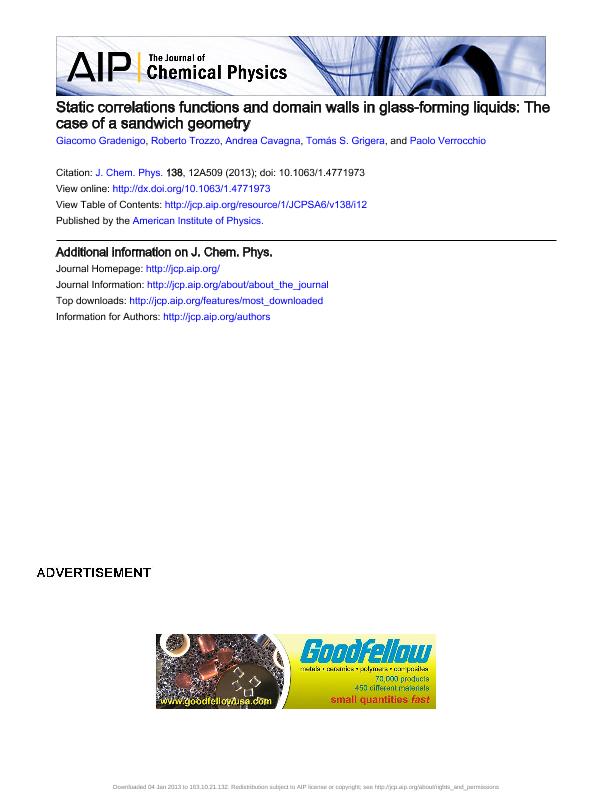Mostrar el registro sencillo del ítem
dc.contributor.author
Gradenigo, Giacomo
dc.contributor.author
Trozzo, Roberto
dc.contributor.author
Cavagna, Andrea
dc.contributor.author
Grigera, Tomas Sebastian

dc.contributor.author
Verrocchio, Paolo
dc.date.available
2016-04-21T17:36:23Z
dc.date.issued
2013-03
dc.identifier.citation
Gradenigo, Giacomo; Trozzo, Roberto; Cavagna, Andrea; Grigera, Tomas Sebastian; Verrocchio, Paolo; Static correlation functions and domain walls in glass-forming liquids: The case of a sandwich geometry; American Institute of Physics; Journal of Chemical Physics; 138; 12; 3-2013; 12A509-12A509
dc.identifier.issn
0021-9606
dc.identifier.uri
http://hdl.handle.net/11336/5314
dc.description.abstract
The problem of measuring nontrivial static correlations in deeply supercooled liquids made recently some progress thanks to the introduction of amorphous boundary conditions, in which a set of free particles is subject to the effect of a different set of particles frozen into their (low temperature) equilibrium positions. In this way, one can study the crossover from nonergodic to ergodic phase, as the size of the free region grows and the effect of the confinement fades. Such crossover defines the so-called point-to-set correlation length, which has been measured in a spherical geometry, or cavity. Here, we make further progress in the study of correlations under amorphous boundary conditions by analyzing the equilibrium properties of a glass-forming liquid, confined in a planar (“sandwich”) geometry. The mobile particles are subject to amorphous boundary conditions with the particles in the surrounding walls frozen into their low temperature equilibrium configurations. Compared to the cavity, the sandwich geometry has three main advantages: (i) the width of the sandwich is decoupled from its longitudinal size, making the thermodynamic limit possible; (ii) for very large width, the behaviour off a single wall can be studied; (iii) we can use “anti-parallel” boundary conditions to force a domain wall and measure its excess energy. Our results confirm that amorphous boundary conditions are indeed a very useful new tool in the study of static properties of glass-forming liquids, but also raise some warning about the fact that not all correlation functions that can be calculated in this framework give the same qualitative results.
dc.format
application/pdf
dc.language.iso
eng
dc.publisher
American Institute of Physics

dc.rights
info:eu-repo/semantics/openAccess
dc.rights.uri
https://creativecommons.org/licenses/by-nc-sa/2.5/ar/
dc.subject
Supercooled Liquids
dc.subject.classification
Física de los Materiales Condensados

dc.subject.classification
Ciencias Físicas

dc.subject.classification
CIENCIAS NATURALES Y EXACTAS

dc.title
Static correlation functions and domain walls in glass-forming liquids: The case of a sandwich geometry
dc.type
info:eu-repo/semantics/article
dc.type
info:ar-repo/semantics/artículo
dc.type
info:eu-repo/semantics/publishedVersion
dc.date.updated
2016-05-06 15:52:43.262787-03
dc.journal.volume
138
dc.journal.number
12
dc.journal.pagination
12A509-12A509
dc.journal.pais
Estados Unidos

dc.journal.ciudad
New York
dc.description.fil
Fil: Gradenigo, Giacomo. Instituto de Investigaciones Universitaria Roma la Sapienza; Italia. Consiglio Nazionale delle Ricerche. Istituto Sistemi Complessi; Italia
dc.description.fil
Fil: Trozzo, Roberto. Instituto de Investigaciones Universitaria Roma la Sapienza; Italia
dc.description.fil
Fil: Cavagna, Andrea. Consiglio Nazionale delle Ricerche. Istituto Sistemi Complessi; Italia. Instituto de Investigaciones Universitaria Roma la Sapienza; Italia
dc.description.fil
Fil: Grigera, Tomas Sebastian. Consejo Nacional de Investigaciones Científicas y Técnicas. Centro Científico Tecnológico la Plata. Instituto de Investigaciones Fisicoquímicas Teóricas y Aplicadas; Argentina. Universidad Nacional de La Plata; Argentina. Instituto de Investigaciones Universitaria Roma la Sapienza; Italia
dc.description.fil
Fil: Verrocchio, Paolo. Università di Trento. Dipartimento di Fisica; Italia. Instituto de Investigaciones Universitaria Roma la Sapienza; Italia. Instituto de Biocomputación y Física de Sistemas Complejos; España
dc.journal.title
Journal of Chemical Physics

dc.relation.alternativeid
info:eu-repo/semantics/altIdentifier/arxiv/1209.5954v1
dc.relation.alternativeid
info:eu-repo/semantics/altIdentifier/doi/10.1063/1.4771973
dc.relation.alternativeid
info:eu-repo/semantics/altIdentifier/url/http://arxiv.org/abs/1209.5954v1
dc.relation.alternativeid
info:eu-repo/semantics/altIdentifier/url/http://scitation.aip.org/content/aip/journal/jcp/138/12/10.1063/1.4771973
dc.relation.alternativeid
info:eu-repo/semantics/altIdentifier/doi/http://dx.doi.org/10.1063/1.4771973
Archivos asociados
